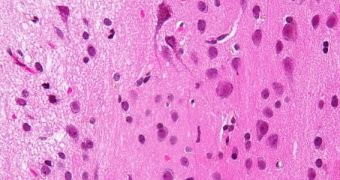Scientists with the School of Physiology and Pharmacology at the University of Bristol, led by researchers Dr. Ana Abdala and professor Julian Paton, announce the development of a potent new drug that holds great promise for treating a rare, yet devastating childhood disease called Rett syndrome.
This condition used to be known as cerebroatrophic hyperammonemia and is characterized by neurodevelopmental disorders affecting gray matter in the human brain. It occurs almost exclusively in female babies and has an incidence level of 1 in 10,000. Some cases have also been found in males.
The gray matter issues Rett syndrome causes have been linked to a wide array of side-effects, ranging from the development of autism-like symptoms and epilepsy to breathing irregularities and loss of muscle control. Repetitive stereotyped hand movements are also very common in this disorder.
Though cataloged as belonging to the same class of diseases as autism spectrum disorders (ASD) and childhood disintegrative disorder (CDD), Rett syndrome may, in fact, be more similar to non-autistic conditions, including the fragile X syndrome, Down syndrome, or tuberous sclerosis.
Researchers have determined that RTT is a genetic disorder, which is largely caused by mutations affecting an X chromosome gene called MECP2. The new drug developed at the University of Bristol, called NLX-101, does not act on this gene, but on a neurotransmitter in the brain. The work was made possible by a grant worth £180,000 ($300,000 / €218,000).
The money, provided by the International Rett Syndrome Foundation and Cure Rett, helped the team set up a series of experiments where NLX-101 was used to address breathing abnormalities, one of the main symptoms of RTT, and an important source of complications, including a higher incidence of epilepsy. The team tested the drug on mouse models of the disease.
The new chemical works by exclusively targeting a particular subtype of serotonin in the human brain, a structure that is engaged in controlling a number of neural functions related to breathing and motor control. “This is the culmination of five years of work. Our preliminary results are robust and reliable. Critically, we understand key elements of how the drug works,” Dr. Abdala explains.
“This is important for translating the research from the laboratory into a clinical treatment for Rett syndrome,” says the researcher. There are currently no known treatments for this disorder, which puts infant girls, their parents, and doctors, in a very stressful position. Not even breathing difficulties can be addressed with existing drugs, so these symptoms account for most of emergency room admissions.
“We are delighted to collaborate with the research team at the University of Bristol on this exciting project. Rett syndrome is a serious neurological disorder and new treatments such as NLX-101 need to be rigorously tested in animal models before moving to the clinic,” adds Dr. Adrian-Newman Tancredi.
The expert holds an appointment as the Chief Scientific Officer (CSO) of Neurolixis, which is a bioscience company that holds the license for developing NLX-101. Additional experiments are in the works, but researchers want to move up to human clinical trials as soon as possible.

 14 DAY TRIAL //
14 DAY TRIAL //